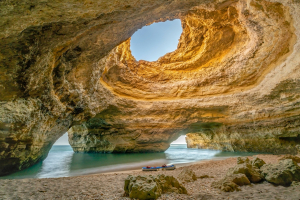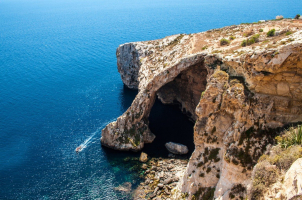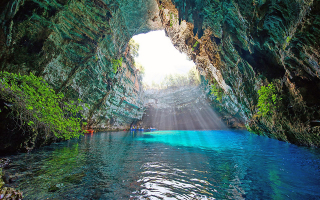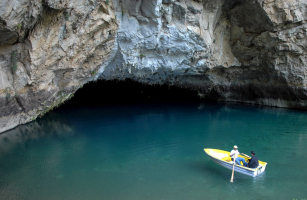Top 7 Most Beautiful Caves in Iran
Iran is a diverse country and home to countless tourist attractions that are similarly hard to find anywhere else. One of the tourist attractions in Iran is ... read more...the amazing caves. Thanks to the numerous caves in Iran, it is a paradise for caving lovers, and every year a large number of nature and adventure lovers come to Iran to explore deep underground. at the beautiful caves in this country. Apart from places like Mount Paraw (Parau), which is full of technical deep caves, here is a list of the most beautiful caves in Iran.
-
Dashkasan, or the Dragon Temple ranks first in the list of the most beautiful caves in Iran, It is located in Veir Village, 10 kilometers southeast of Soltaniyeh. Dashkasan is made up of three deep, man-made caves with beautiful stone carvings. The depiction of two 3.5-meter dragons confronting each other is one of these engravings. On either side of these carvings, there are altars with floral and arabesque designs, as well as stone Muqarnas embellishments. According to one interpretation, these carvings were commissioned by Ilkhanid ruler Oljeitu (1280–1316) and created by Chinese craftsmen. According to other researchers, this temple was first utilized by Mithra's disciples in Sassanid (226-651 CE) Iran, and then by the Ilkhanids before they converted to Islam.
The Dashkasan Dragon Temple was built in the early 14th century by Mongol monarch ljaitü. The sacred sanctuary was created by quarring three caverns into the mountain. The rectangular temple was erected by four Chinese artisans, who also carved the stunning dragon statues that span both sides. The dragons, which stand about 10 feet (3 meters) tall, are encircled by more typical Islamic patterns like flowers. Within the temple, a mihrab, a recess in the wall that marks the direction of Mecca, was also added. Some researchers claim that during the Sassanid period, the Zora-Astrian worshippers of Mithras (God of Light and Truth) used this temple (224 to 651). The temple's excavations are still half-completed today. Outside the temple, columns and rubble have been removed. With hundreds of fallen bricks strewn about, the area resembles a toddler's playground.
Location: south-east of Soltaniyeh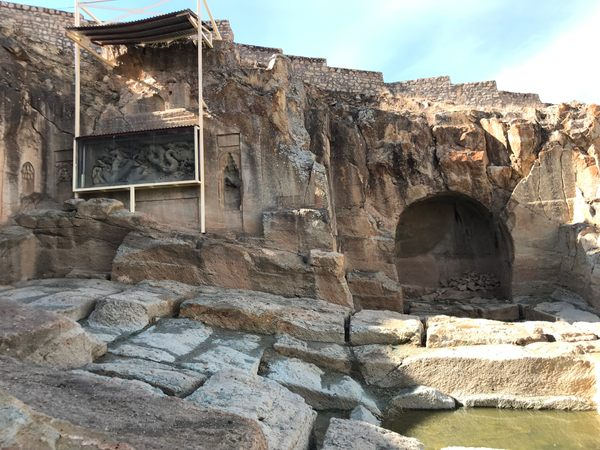
atlasobscura.com 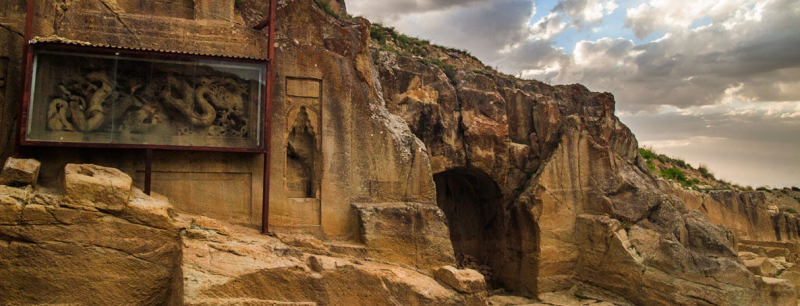
surfiran.com -
2nd place in the list of the most beautiful caves in Iran is Ali Sadr Cave. It is one of the world's largest subterranean water complexes, with a network of channels, lakes, and aqueous tunnels spanning several kilometers. The sunless grottoes, which have been stable for millions of years, contain pristine pools, fanciful rock formations, and stalactite-covered ceilings that soar high above. Unlike many other aquatic caves, Ali Sadr's body of water is not a moving river, but a large, web-like lake that appears to be fed by spring waters from adjacent Sarab Cave. Ali Sadr visitors are taken to an underground port where they board boats that take them silently through a series of flooded chambers.
Above and below the surface of the water, which is clear enough to give visibility to a depth of five meters, colorful, sparkling geological features cover the tunnel walls. Tight, winding corridors split off in all directions or open up into gigantic chambers like the Wedding Room (also known as the 1000 Stalactites Room), the Island (located in the complex's heart), and the 600-meter-long Freedom Hall (the largest chamber in the network). The cave was occupied by early humans starting 12,000 years ago, according to prehistoric murals, pitchers, and jugs discovered on site.
During the era of Darius I (521-485 BCE), a new entrance to Ali Sadr was built, but the cave was probably neglected after that, and it was finally unearthed in 1963. Mountaineers and geologists from Iran and beyond have been exploring it since then. Its current known extent is 11 kilometers, with the longest passage mapped so far covering nearly the same distance. The regular tour takes tourists on a 2100-meter excursion through Ali Sadr Cave, with a boat covering 1470 meters of that route, making it one of the world's longest subterranean boat rides.
Location: Street Culture, Ali SadrIran

destinationiran.com 
destinationiran.com -
The age of the Maymand settlement was calculated using remains of stone etchings that proved the presence of human settlers. However, the village's distinctive feature, its 300+ underground cave homes, is not nearly as old, dating back barely 3-4,000 years. The cave shelters are assumed to have started out as sacred structures, but as inhabitants stayed longer and longer, they gradually evolved into permanent homes. Locals claim that instead of utilizing standard tools, their forefathers chiseled out the basic cave homes using a sort of hard, sharpened stone found in the area.
Even though the single-room houses are frequently stacked four or five stories high, each of the desolate caves has its own stove area. The complex of caves that make up the town are miraculously still inhabited today for such an ancient and harsh settlement. Some of the houses are supposed to have been occupied continuously since they were built thousands of years ago. The population was 673 in 2006, but it fluctuates according to the seasons. Although the caves have a bleak beauty, they are not exactly luxurious accommodations.
Location: Meymand. Iran
tripadvisor.com.vn 
tripadvisor.com.vn -
Kandovan ranks 4th in the list of the most beautiful caves in Iran. It is a tourist village in the province of East Azerbaijan, claims to be more than 700 years old, according to its current population. It was constructed, according to legend, when people escaping the invading Mongol army sought refuge in caves. In the native Turkic dialect, the houses are called "karan," which approximately translates to "beehive multiple."
The Kandovan settlement has an odd appearance that more closely resembles a massive termite colony than typical caverns. When Mount Sahand erupted in the last 11,000 years, ash and debris from the now-dormant volcano built the structures. The ash hardened over thousands of years, allowing the elements to chisel it out. The ash blanketed the earth in a more customary pattern throughout the surrounding area. The residents of the community have expanded their homes throughout time. Most cave dwellings now include two to four storeys, containing living quarters, storage areas, and animal shelters. Porches, windows, doors, and stairwells have been carved into the rock in several cases. The caves are some of the most energy efficient residences on the planet, with enough insulation provided by the rock to keep the interiors warm during the lengthy winter season. In the summer, the houses are also kept cool.
Location: Osku - Kandovan Rd, KandovanIran
unwto.org 
unwto.org -
Qeshm Island's Namakdan Mountain. The salt cave is located on the island's western side. You'll find your way if you look for signs that say 'Salt caves.' Only one of the entrances is open to the public, and it is free to enter. While the rock in the salt cave is dissolved by water that seeps in through fissures, unlike other caves of chalk, marble, or gypsum, changes in the appearance of the salt cave can happen in days rather than millennia. Salt caverns are delicate structures that are formed and destroyed in a matter of hundreds of years.
"In limestone caves, there are signs warning visitors not to touch the dripstones; they have been developing for thousands of years, whereas in salt caverns, dripstones grow for days or weeks after rain, when rainwater enters the rock, saturates it, and in a month, half-metre dripstones have formed." They're virtually growing in front of our eyes." Michal Filippi, a member of the Czech project Namak (which means salt in Persian), which has been exploring this cave for over a decade, said as much. In 1997, Filippi and Jiri Bruthans, both students, followed their lecturer into the extremely hot cave.
Location: Qeshm Island's Namakdan Mountain

kidsvt.com 
byrdie.com -
Roodafshan Cave ranks 6th in the list of the most beautiful caves in Iran. It is another popular tourist attraction in Iran. This cave can be found 103 kilometers east of Tehran and 62 kilometers west of Firoozkuh. The Roodafshan Cave is a popular tourist attraction in Tehran. On the foothills of the Alborz mountains in the rugged region of central Alborz, this cave overlooks Roodafshn village and Damavand city. The oval aperture of Roodafshan Cave, which is located at an elevation of 1945 meters above sea level. The mouth of the Roodafshan cave, which is 12 meters high and 40 meters long, is one of Iran's three greatest cave openings.
In Roodafshan Cave, there are various passages, the longest of which is 800 meters long, and the cave's entire length is 1637 meters. Changiz Sheikhali, the Iranian pioneer of speleology, discovered Roodafshan Cave in 1949, and it was included to the National Register in 2006. Roodafshan cave is one of Iran's limestone caverns, produced over millions of years by the dissolving of limestone by the steady flow of water. The magnificent icicle-shaped rock formations known as Stalactite and stalagmite can be seen by entering the cave and walking through it for a while. You might be wondering what the difference is between a stalactite and a stalagmite!
Location: Roodafshan valley, Damavand County, Tehran Province, Iran
iranparadise.com -
Ghar-e-Danial is another popular tourist attraction in Iran (Danial Cave). After Quri Qala Cave, Danial Cave is the second river cave in Mazandaran Province, Salman Shahr. The cave's river isn't very deep; most of the cave's river isn't more than one meter deep. The water in most caves contains a significant amount of minerals, limestones, and other minerals. This is not the case with the Danial Cave River, which boasts crystal clear water with a low mineral content.
Danial Cave reaches a height of almost 2,100 meters and a depth of more than 70 meters. The cave's mouth is situated at a height of 160 meters above sea level. To pass via the Danial Cave, one must cross the entire way through water. Talar-e-Rizan (Rizan Hall) with hanging rock formations (Stalactites) and Talar-e-Khofash (Bat Hall) with foul odors are two of the cave's sections.
Location: the mountain range of Alborz

en.irna.ir






















